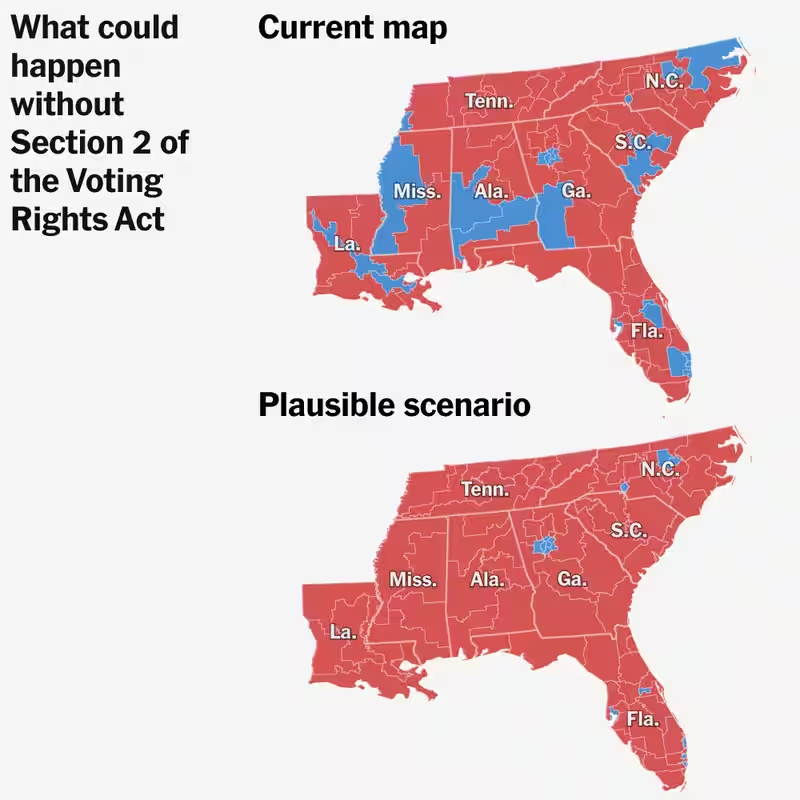Voting Rights Act protections that have safeguarded minority representation for decades are now on the chopping block—and the political fallout could reshape Congress. As the U.S. Supreme Court reconsiders a Louisiana redistricting case, legal experts and civil rights advocates warn that a ruling against Section 2 of the Voting Rights Act could eliminate up to a dozen Democratic-held, majority-minority House districts across the South, handing Republicans a decisive edge in the narrowly divided chamber.
Why the Voting Rights Act Is Back in the Crosshairs
The case, Louisiana v. Callais, began as a dispute over whether the state’s 2024 congressional map—which created a second majority-Black district—constituted an illegal racial gerrymander. But in a rare procedural move, the Supreme Court has expanded the scope of the rehearing to question the very constitutionality of Section 2 itself.
Section 2 is the last major enforcement mechanism of the 1965 Voting Rights Act. It allows voters to sue when election maps or laws dilute minority voting power. Without it, there would be no federal legal recourse to challenge discriminatory redistricting after the fact.
Voting Rights Act at Risk: What’s at Stake?
If the Court rules that race cannot be considered in drawing district lines—even to correct historical discrimination—the consequences would be immediate and sweeping:
- At least 12 Democratic-held seats in Southern states like Louisiana, Alabama, Georgia, and North Carolina could be redrawn or eliminated.
- Black, Latino, and Native American communities could lose meaningful representation in Congress.
- Republicans could gain enough seats to solidify control of the House through 2026 and beyond.
“This isn’t hypothetical,” said Janai Nelson, president of the NAACP Legal Defense Fund, during oral arguments. “We only have the diversity we see across the South because of litigation under Section 2.”
How Louisiana’s Map Became a National Flashpoint
After the 2020 census revealed that Black residents made up one-third of Louisiana’s population, federal courts ordered the state to create a second majority-Black congressional district. Lawmakers complied—but claimed they did so for political, not racial, reasons, aiming to protect GOP incumbents like Speaker Mike Johnson and Majority Leader Steve Scalise.
Yet soon after the new map passed, a group of white voters sued, arguing it was an unconstitutional racial gerrymander. A federal panel agreed and struck it down. Louisiana appealed—and the Supreme Court not only paused that ruling but scheduled a rare reargument, signaling deep interest in redefining voting rights law.
Timeline of the Voting Rights Act’s Erosion
| Year | Event |
|---|---|
| 1965 | Voting Rights Act signed into law |
| 1982 | Congress amends Section 2 to cover discriminatory effects, not just intent |
| 2013 | Shelby County v. Holder eliminates Section 5 preclearance |
| 2023 | Court upholds Section 2 in Alabama redistricting case |
| 2025 | Supreme Court reargues Louisiana case—now targeting Section 2 directly |
Political Implications: A Quiet Power Grab?
What makes this case especially alarming to Democrats is the timing. With the House majority hanging by a thread, eliminating even a handful of majority-minority districts could tip the balance. In Louisiana alone, the newly drawn district elected Cleo Fields—a Black Democrat—flipping a seat previously held by a Republican.
Similar gains occurred in Alabama, where Shomari Figures won under a court-ordered map. Both victories stemmed directly from Section 2 litigation.
Justice Brett Kavanaugh, who sided with liberals in the 2023 Alabama case, now questions whether race-based remedies should have a “sunset date.” Chief Justice John Roberts, long skeptical of race-conscious policies, echoed that sentiment, asking whether the Constitution permits any use of race in redistricting.
Louisiana’s Stunning Reversal
In a dramatic shift, Louisiana’s Republican leadership—once defending the two-district map—has now joined the plaintiffs. Attorney General Liz Murrill declared Section 2 “unworkable and unconstitutional,” arguing it relies on “racial stereotypes.”
“Our Constitution sees neither Black voters nor white voters; it sees only American voters,” she said—a line that civil rights groups call a dangerous oversimplification that ignores systemic inequities.
Broader Impact Beyond the South
While much of the focus is on Southern states, Section 2 has been used nationwide—from New York school boards to Native American voting access in Montana and South Dakota. Striking it down would silence minority voices in local and state elections too.
As former Attorney General Eric Holder warned: “Any decision that fails to reaffirm precedent could shatter Americans’ faith in the judicial system.”
Sources
The New York Times: The Supreme Court Case That Could Hand the House to Republicans
NYT Live Updates: Supreme Court Questions Role of Race in State Election Maps




